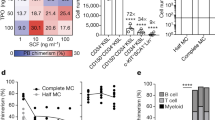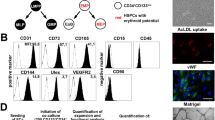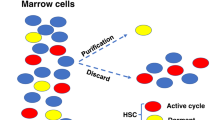Abstract
The method for long-term culture of marrow cells in vitro as described by Dexter1 has recently been successfully applied to human marrow2,3 and is dependent on the development of an adherent stromal cell layer consisting of cells described as “endothelial-like cells, fat cells, and macrophages” 4. The present study was designed to determine the origin and composition of the stromal cells forming the in vitro ‘microenvironment’ and maintaining haematopoeisis in long-term cultures grown from marrows of 14 patients who received marrow transplants from HLA identical siblings of the opposite sex. The presence of a Y chromosome was used as a marker to establish the donor or recipient origin of the cells. We found that the stromal cells became progressively donor in origin with time after transplantation and some reacted with antibody directed against factor VIII-associated antigen. In addition, donor-derived in vitro stromal cells synthesized both interstitial and basal lamina collagen types, indicating that the in vitro microenvironment is transplantable and composed in part of endothelial-like cells.
This is a preview of subscription content, access via your institution
Access options
Subscribe to this journal
Receive 51 print issues and online access
$199.00 per year
only $3.90 per issue
Buy this article
- Purchase on Springer Link
- Instant access to full article PDF
Prices may be subject to local taxes which are calculated during checkout
Similar content being viewed by others
References
Dexter, T. M., Allen, T. D. & Lajtha, L. G. J. cell. Physiol. 91, 335–344 (1977).
Gartner, S. & Kaplan, H. S. Proc. natn. Acad. Sci. U.S.A. 77, 4756–4759 (1980).
Greenberg, H. M., Newberger, P. E., Parker, L. M., Novak, T. & Greenberger, J. S., Blood 58, 724–732 (1981).
Dexter, T. M. & Testa, N. G. J. immun. Meth. 38, 177–190 (1980).
Thomas, E. D. et al. New Engl. J. Med. 292, 832–843 (1975).
Singer, J. W., Fialkow, P. J., Dow, L. W., Ernst, C. & Steinmann, L. Blood 54, 1395–1399 (1979).
Pearson, P. L., Burrow, M. & Vosa, C. G. Nature 226, 78–80 (1970).
Striker, G. E., Harlan, J. M. & Schwartz, S. M. Meth. Cell Biol. A 21, 135–151 (1980).
Killen, P. D. & Striker, G. E. Proc. natn. Acad. Sci. U.S.A. 76, 3518–3522 (1979).
Li, C. Y., Lam, K. W. & Yam, L. T. J. Histochem. Cytochem. 21, 1–12 (1973).
Thomas, E. D., Ramberg, R. E., Sale, G. E., Sparkes, R. S. & Golde, D. W. Science 192, 1016–1018 (1976).
Dexter, T. M., Allen, T. D. & Lajtha, L. G. J. cell. Physiol. 91, 335–344 (1977).
Friedenstein, A. J. et al. Expl Hemat. 6, 440–444 (1970).
Wilson, F. D., Greenberg, B. R., Konrad, N. P., Klein, A. K. & Walling, P. A. Transplantation 25, 87–88 (1978).
Golde, D. W., Hocking, W. G., Quan, S. G., Sparkes, R. S. & Gale, R. P. Br. J. Haemat. 44, 183–187 (1980).
Hock, E. B. Am. J. hum. Genet. 29, 94–97 (1977).
Bentley, S. A., Alabaster, O. & Foidart, J. M. Br. J. Haemat. 48, 287–291 (1981).
Minick, C. R., Edelman, B., Becker, C. G. & Nachman, R. L. J. exp. Med. 144, 209–225 (1976).
Sabin, F. R. Contr. Embryol. 9, 213–262 (1920).
Maximow, A. A. Physiol. Rev. 4, 533–563 (1924).
Author information
Authors and Affiliations
Rights and permissions
About this article
Cite this article
Keating, A., Singer, J., Killen, P. et al. Donor origin of the in vitro haematopoietic microenvironment after marrow transplantation in man. Nature 298, 280–283 (1982). https://doi.org/10.1038/298280a0
Received:
Accepted:
Issue Date:
DOI: https://doi.org/10.1038/298280a0
This article is cited by
-
Mesenchymal stem cells for chronic wounds therapy
Cell and Tissue Banking (2015)
-
Organization of immunological memory by bone marrow stroma
Nature Reviews Immunology (2010)
-
Renal repair: role of bone marrow stem cells
Pediatric Nephrology (2008)
-
Mobilizing stem cells from normal donors: is it possible to improve upon G-CSF?
Bone Marrow Transplantation (2007)
-
Engraftment capacity of mesenchymal cells following hematopoietic stem cell transplantation in patients receiving reduced-intensity conditioning regimen
Leukemia (2006)
Comments
By submitting a comment you agree to abide by our Terms and Community Guidelines. If you find something abusive or that does not comply with our terms or guidelines please flag it as inappropriate.



